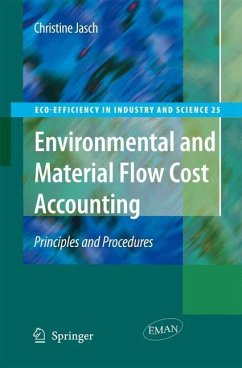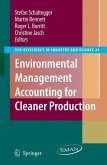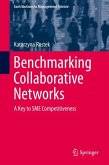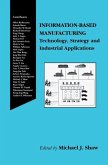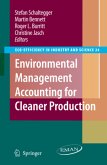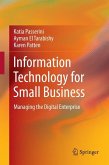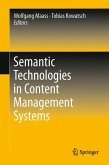- Broschiertes Buch
- Merkliste
- Auf die Merkliste
- Bewerten Bewerten
- Teilen
- Produkt teilen
- Produkterinnerung
- Produkterinnerung
Recognizing the increasing importance of environmental issues, energy prices, material availability and efficiency and the difficulty of adequately managing these issues in traditional accounting systems, several companies all over the world have started implementing "Environmental and Material Flow Cost Accounting" (EMA and MFCA).
"Environmental and Material Flow Costs Accounting" explains and updates the approach developed for the United Nations Department of Economic and Social Affairs (DSD/UNDESA) and the International Federation of Accountants (IFAC) and in addition includes…mehr
Andere Kunden interessierten sich auch für
![Environmental Management Accounting for Cleaner Production Environmental Management Accounting for Cleaner Production]() Stefan Schaltegger / Martin Bennett / Roger L. Burritt / Christine Jasch (ed.)Environmental Management Accounting for Cleaner Production161,99 €
Stefan Schaltegger / Martin Bennett / Roger L. Burritt / Christine Jasch (ed.)Environmental Management Accounting for Cleaner Production161,99 €![Benchmarking Collaborative Networks Benchmarking Collaborative Networks]() Katarzyna RostekBenchmarking Collaborative Networks41,99 €
Katarzyna RostekBenchmarking Collaborative Networks41,99 €![Information-Based Manufacturing Information-Based Manufacturing]() Michael J. Shaw (ed.)Information-Based Manufacturing83,99 €
Michael J. Shaw (ed.)Information-Based Manufacturing83,99 €![Environmental Management Accounting for Cleaner Production Environmental Management Accounting for Cleaner Production]() Environmental Management Accounting for Cleaner Production161,99 €
Environmental Management Accounting for Cleaner Production161,99 €![Information Technology for Small Business Information Technology for Small Business]() Katia PasseriniInformation Technology for Small Business97,99 €
Katia PasseriniInformation Technology for Small Business97,99 €![Design Thinking Research Design Thinking Research]() Design Thinking Research81,99 €
Design Thinking Research81,99 €![Semantic Technologies in Content Management Systems Semantic Technologies in Content Management Systems]() Semantic Technologies in Content Management Systems81,99 €
Semantic Technologies in Content Management Systems81,99 €-
-
-
Recognizing the increasing importance of environmental issues, energy prices, material availability and efficiency and the difficulty of adequately managing these issues in traditional accounting systems, several companies all over the world have started implementing "Environmental and Material Flow Cost Accounting" (EMA and MFCA).
"Environmental and Material Flow Costs Accounting" explains and updates the approach developed for the United Nations Department of Economic and Social Affairs (DSD/UNDESA) and the International Federation of Accountants (IFAC) and in addition includes experiences of several case studies and recent developments regarding EMA and MFCA in national statistics and ISO standardization.
"Environmental and Material Flow Costs Accounting" explains and updates the approach developed for the United Nations Department of Economic and Social Affairs (DSD/UNDESA) and the International Federation of Accountants (IFAC) and in addition includes experiences of several case studies and recent developments regarding EMA and MFCA in national statistics and ISO standardization.
Produktdetails
- Produktdetails
- Eco-Efficiency in Industry and Science 25
- Verlag: Springer / Springer Netherlands
- Artikelnr. des Verlages: 978-90-481-8053-0
- Softcover reprint of hardcover 1st edition 2009
- Seitenzahl: 220
- Erscheinungstermin: 22. November 2010
- Englisch
- Abmessung: 235mm x 155mm x 13mm
- Gewicht: 341g
- ISBN-13: 9789048180530
- ISBN-10: 9048180538
- Artikelnr.: 32451142
- Herstellerkennzeichnung Die Herstellerinformationen sind derzeit nicht verfügbar.
- Eco-Efficiency in Industry and Science 25
- Verlag: Springer / Springer Netherlands
- Artikelnr. des Verlages: 978-90-481-8053-0
- Softcover reprint of hardcover 1st edition 2009
- Seitenzahl: 220
- Erscheinungstermin: 22. November 2010
- Englisch
- Abmessung: 235mm x 155mm x 13mm
- Gewicht: 341g
- ISBN-13: 9789048180530
- ISBN-10: 9048180538
- Artikelnr.: 32451142
- Herstellerkennzeichnung Die Herstellerinformationen sind derzeit nicht verfügbar.
Foreword.- Executive Summary.- 1. What is EMA and why is it relevant?- 1.1 The issues behind EMA.- 1.2. Challenges for current accounting practices.- 1.3. Definition of environmental costs and environmental managementaccounting (EMA).- 1.4. Monetary accounting.- 1.5. Physical accounting.- 1.6. EMA Links to Financial, Statistical, Environmental and Sustainability Reporting Requirements.- 1.7. EMA uses and benefits.- 2. The input side of the material flow balance.- 2.1 Overview on material flow balances.- 2.2. Raw Materials.- 2.3 Auxiliary Materials.- 2.4. Merchandise.- 2.5 Packaging.- 2.6. Operating Materials.- 2.7. Energy.- 2.8. Water.- 3. The output side of the material flow balance.- 3.1 Products and by-products.- 3.2. Non-Product Outputs (Waste and Emissions).- 4. Environmental performance indicators.- 4.1 ISO 14031 - Standard on environmental performance evaluation.- 4.2 Environmental performance indicators of GRI.- 4.3 General requirements for indicator systems.- 4.4 System boundaries for performance indicators.- 4.5 The problem of finding a meaningful denominator.- 4.6 Calculating savings based on performance indicators.- 5. Environmentally relevant equipment.- 5.1 Classification of environmentally relevant equipment.- 5.2 Environmental investments according to SEEA and CEPA.- 6. Monetary information.- 6.1 Overview on the EMA cost categories in the Excel template for total annual environmental costs.- 6.2 Distribution by environmental domain.- 6.3 Material Costs of Non-Product Output.- 6.4 Waste and emission control costs.- 6.5 Costs for Prevention and other Environmental Management Costs.- 6.6 Research and Development Costs.- 6.7 Environmental Earnings and Savings.- 6.8 Case study of SCA Laakirchen pulp and paper plant.- 7. Linking physical and monetary information.- 7.1 Environmental expenditure in the profit and loss statement.- 7.2 Improving the Consistency of Materials Inputs and Product and Non-Product Output.- 7.3 Tracing Materials in corporate information systems.- 7.4 Cost accounting basics and terminology.- 7.5 Mapping costs centers, production planning and technical monitoring.- 7.6 Activity based costing.- 7.7 Material Flow Cost Accounting (MFCA).- 7.8 Investment appraisal and budgeting.- 7.9. Benchmarking production sites.- 8. Case study of a brewery.- 8.1 Working with the EMA excel templates.- 8.2 The material flow balance.- 8.3 The brewery, its production flow and cost centers.- 8.4 Total annual environmental costs.- 9. How to organize an EMA pilot project.- 9.1 Defining system boundaries and sites for pilot testing.- 9.2 Developing a project plan.- 9.3 Extracting EMA data from Enterprise Resource Planning Systems.- 9.4 Elements of an internal EMA standard.- 9.5 Summary of recommendations from case studies.- 9.6 Outlook.- 10. Annex.- 10.1 Checklists for environmental costs by environmental domains.- References.- Index.
Foreword.- Executive Summary.- 1. What is EMA and why is it relevant?- 1.1 The issues behind EMA.- 1.2. Challenges for current accounting practices.- 1.3. Definition of environmental costs and environmental managementaccounting (EMA).- 1.4. Monetary accounting.- 1.5. Physical accounting.- 1.6. EMA Links to Financial, Statistical, Environmental and Sustainability Reporting Requirements.- 1.7. EMA uses and benefits.- 2. The input side of the material flow balance.- 2.1 Overview on material flow balances.- 2.2. Raw Materials.- 2.3 Auxiliary Materials.- 2.4. Merchandise.- 2.5 Packaging.- 2.6. Operating Materials.- 2.7. Energy.- 2.8. Water.- 3. The output side of the material flow balance.- 3.1 Products and by-products.- 3.2. Non-Product Outputs (Waste and Emissions).- 4. Environmental performance indicators.- 4.1 ISO 14031 - Standard on environmental performance evaluation.- 4.2 Environmental performance indicators of GRI.- 4.3 General requirements for indicator systems.- 4.4 System boundaries for performance indicators.- 4.5 The problem of finding a meaningful denominator.- 4.6 Calculating savings based on performance indicators.- 5. Environmentally relevant equipment.- 5.1 Classification of environmentally relevant equipment.- 5.2 Environmental investments according to SEEA and CEPA.- 6. Monetary information.- 6.1 Overview on the EMA cost categories in the Excel template for total annual environmental costs.- 6.2 Distribution by environmental domain.- 6.3 Material Costs of Non-Product Output.- 6.4 Waste and emission control costs.- 6.5 Costs for Prevention and other Environmental Management Costs.- 6.6 Research and Development Costs.- 6.7 Environmental Earnings and Savings.- 6.8 Case study of SCA Laakirchen pulp and paper plant.- 7. Linking physical and monetary information.- 7.1 Environmental expenditure in the profit and loss statement.- 7.2 Improving the Consistency of Materials Inputs and Product and Non-Product Output.- 7.3 Tracing Materials in corporate information systems.- 7.4 Cost accounting basics and terminology.- 7.5 Mapping costs centers, production planning and technical monitoring.- 7.6 Activity based costing.- 7.7 Material Flow Cost Accounting (MFCA).- 7.8 Investment appraisal and budgeting.- 7.9. Benchmarking production sites.- 8. Case study of a brewery.- 8.1 Working with the EMA excel templates.- 8.2 The material flow balance.- 8.3 The brewery, its production flow and cost centers.- 8.4 Total annual environmental costs.- 9. How to organize an EMA pilot project.- 9.1 Defining system boundaries and sites for pilot testing.- 9.2 Developing a project plan.- 9.3 Extracting EMA data from Enterprise Resource Planning Systems.- 9.4 Elements of an internal EMA standard.- 9.5 Summary of recommendations from case studies.- 9.6 Outlook.- 10. Annex.- 10.1 Checklists for environmental costs by environmental domains.- References.- Index.

